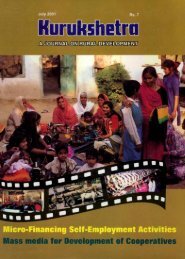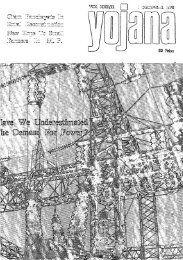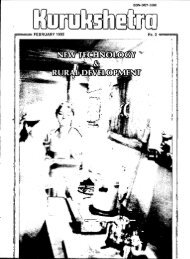Banking - Yojana
Banking - Yojana
Banking - Yojana
- TAGS
- banking
- yojana
- yojana.gov.in
Create successful ePaper yourself
Turn your PDF publications into a flip-book with our unique Google optimized e-Paper software.
Generated by PDFKit.NET Evaluation<br />
work had "unquestionably inspired<br />
substantial research during the<br />
1970s on the effect of monetary<br />
policy, the implications of<br />
government budget deficits, and<br />
stabilization policyin general". The<br />
award was viewed as the highest<br />
recognition in the profession, being<br />
accorded to an improbable<br />
champion of Keynesian,<br />
interventionist, redistributive, and<br />
egalitarian economics in its darkest<br />
hour due to the ascendancy of the<br />
monetarists and other conservatives<br />
and the Reagan presidency in the<br />
second half of the 1970s. Tobin<br />
regarded his Nobel Prize as a vote<br />
of confidence to the Keynesian<br />
theory. Tobin's Keynesian-type<br />
macro economic models have<br />
become more eclectic. The Nobel<br />
Prize is an example of an award for<br />
theoretical contributions<br />
concerning specific aspects or<br />
sectors of an economy-viz.,<br />
"portfolio models of financial<br />
mark~ts and their relations to<br />
expenditure decisions,employment,<br />
production and prices".<br />
James Tobin wasborn on March<br />
5, 1918, in Champaign, Illinois as,<br />
the son of Louis M. Tobin, a<br />
journalist, and Margaret Edgerton<br />
Tobin, a social worker. He had a<br />
brilliant academic career at<br />
Harvard in 1930s. Joseph A.<br />
Schumpeter, Edward Chamberlin,<br />
WassilyLeontief, Seymour Harris,<br />
AlvinHansen, Ed Mason and other<br />
members of the faculty that has<br />
become legendary taught him<br />
economics. His men tor Schumpeter<br />
washis teacher and his Ph. D thesis<br />
advisor.A whole battery of veterans<br />
like Paul Samuelson, LloydMetzler,<br />
Richard Goodwin, Paul Sweezyand<br />
Bob Solow as graduate students at<br />
Harvard was around Tobin. He<br />
graduated from Harvard in 1939<br />
an~ interrupted his postgraduate<br />
studies to serve in the U.S navyfrom<br />
1942-46, completing his Harvard<br />
36<br />
Click here to unlock PDFKit.NET<br />
Ph.D in 1947.In 1950hejoined the<br />
YaleEconomics department, where<br />
he became Sterlingprofessorin 1957<br />
and served two stints (1955-61and<br />
1964-65) as director of the Cowles<br />
Foundation for Research in<br />
Economics.<br />
Revival<br />
Tobin's type of macroeconomic<br />
models heralded a genuine<br />
Keynesian revival, leading to a<br />
great variety of economicmodels.<br />
Tobin's scholarly output has been<br />
substantial and so wide-ranging in<br />
its reach and perception that it is<br />
impossible to summarise<br />
adequately. He is best known,<br />
however, for his important<br />
researches in macroeconomic and<br />
monetary theory. The Nobel Prize<br />
awarded to him in 1981wasfor his<br />
pioneer contributions to portfolio<br />
selection theory (where he laid the<br />
foundations for the modern theory<br />
of finance) and for his analyses of<br />
general monetary framework, i.e.,<br />
of the interactions between real<br />
and financial markets, involving a<br />
path-breaking application of<br />
general equilibrium ~heory. Don<br />
Patinkin pioneered thISapproach.<br />
He introduced stock markets into<br />
his models. M. Mussa also<br />
introduced stock markets in to his<br />
model. His analyses of the<br />
determinants of consumption and<br />
investment behaviour, or of the<br />
real/financial transmission<br />
mechanisms involved in<br />
aggregative models of economic<br />
growth and fluctuations and his<br />
contributioI,).s to current<br />
controversy on stabilization theory<br />
and policy have urgent immediate<br />
conC;:,ernto theorists and policy<br />
makers. In addition, he has<br />
developed a new st~tistical and<br />
econometric technique and made<br />
significant contributions to social<br />
policy debates on poverty and<br />
unemployment.<br />
Tobin as a Keynesian economist<br />
has been in the forefront of<br />
developing a general-equilibrium<br />
portfolio approach to financial<br />
analysis incorporating a<br />
comprehensive monetary<br />
transmission mechanism. Tobin's<br />
portfolio model of asset choice<br />
shows that wealth-owners willhold<br />
a diversified portfolio of assets,one<br />
of which is money. Holding a<br />
number of different assets reduces<br />
the overall risk of a portfolio by the<br />
well-known prin.ciple of note<br />
putting all one's eggs in to the<br />
same basket. An asset is generally<br />
thought to be riskier, the greater<br />
the likelihood of its actual return<br />
diverging from its expected return.<br />
Harry M. Markowitz (1959) and<br />
William Sharpe (1970) also<br />
brought out modern portfolio<br />
theory. The theory of<br />
diversification was based on the<br />
work of Markowitz.<br />
In the simplified version of<br />
Tobin's model of asset holding<br />
(1958), there are just two assets:<br />
money, which is risk less because it<br />
has a certain return-of zero; and<br />
perpetual bonds, which are risky.<br />
Tobin's analysiscan be extended to<br />
the selection of a large number of<br />
riskyassets.Each investorisassumed<br />
to be risk-averse. This means that<br />
the expected return from a<br />
portfolio of assets yields positive<br />
utility but the risk gives negative<br />
utility.The individual can make ulA .<br />
an asset portfolio, which consists 0'"<br />
various combinations of the riskless<br />
asset, money, and the risky asset,<br />
bonds. The greater the proportion<br />
of wealth held in bonds, the higher<br />
the expected return from the<br />
portfolio, but the higher also is its<br />
risky ness. The individual chooses<br />
that combination 'of money and<br />
bonds, which maximizes his utility<br />
given his preferences regarding<br />
return and risk. Thus Tobin has<br />
YOJANAJuly2002






